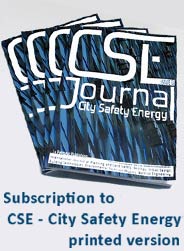Earthquake, urban form and city planning: research perspectives
Abstract
The study on the seismic vulnerability of cities and urban fabrics, referring to the susceptibility to the loss of a city's organization during an earthquake, has become a scientific field which for some time now has acquired own particular specificity, and which involves different research lines and experimentations in the broad area of the sciences on the relationship between earthquakes and human settlements. This is due to several different reasons.
Firstly, building vulnerability in a settlement and the intrinsic vulnerability of the urban structure have been considered for a while to be closely inter-dependent and complementary, and that the appropriate approach to their study should begin from basic hypotheses and concepts which are quite different.
In particular, the studies on a town's seismic vulnerability mainly depend on a series of factors directly linked to the different underlying content and approaches which are, in fact, from a different point of view, the features of the urban-planning discipline. These factors are mainly linked to the concepts of urban structure and urban fabric, concepts which have always been of key importance in the study and design of urban form.
Concerning the above, at the present moment inItaly, some principal fields of experimentation and research can be identified, regarding the relationship between earthquakes and towns.
The aim of this paper is to present an overview of the main points of the most important of the research lines, briefly discussing their respective content and specific features. Therefore, a brief but specific detailed study will be made, based on a “field” experience currently being carried out in the town of Bevagna in the Umbria region. It is a case where the seismic vulnerability study of a town is being conducted simultaneously with a study regarding the appropriate integrating of urban-planning and regional tools. Finally, some important development and research lines will be outlined, where specific perspectives for refining the studies and tools will be highlighted.
Keywords
Read the full text
Download PDFReferences
Bramerini F., G.P. Cavinato, and V. Fabietti (eds) Strategie di mitigazione del rischio sismico e pianificazione. CLE: Condizione Limite per l’Emergenza. Roma: Urbanistica Dossier 130, INU Edizioni, 2013.
Cappuccitti A., and E. Piroddi (eds) Il Nuovo Manuale di Urbanistica. Volume III, Lo stato della Pianificazione urbana in Italia. 20 città a confronto. Torino, Milano, Trento, Bolzano, Trieste, Venezia, Genova, Bologna, Firenze, Ancona, Terni, L’Aquila, Roma, Napoli, Campobasso, Matera, Bari, Reggio Calabria, Palermo, Cagliari. Roma: Mancosu Editore, 2009.
Fabietti, V. “Dalla CLE alla SUM: i contenuti urbanistici della protezione dei rischi”. Urbanistica Dossier 130. Roma: INU Edizioni, 2013: 38-40.
Imbesi G., A. Cappuccitti and C. Di Berardino. “Rischio sismico e strumenti urbanistici nel PRG di Bevagna”. Urbanistica Informazioni, n° 237. Roma: INU Edizioni, 2011: 60-63.
Olivieri M. (Coordinator), F. Fazzio, R. Parotto, and B. Pizzo, Linee guida per la definizione della Struttura Urbana Minima nel PRG. Regione Umbria, DPTU – Dipartimento di Pianificazione Territoriale e Urbanistica, Sapienza Università di Roma. Deliberazione della Giunta regionale della Regione Umbria 8 feb. 2010, n. 164 “Linee guida per la definizione della Struttura Urbana Minima (SUM) nel PRG, ai fini della riduzione della vulnerabilità sismica urbana (Art. 3, comma 3, let. d) della LR 22 febbraio 2005, n. 11, Official Bullettin, Region of Umbria, March 2010.
Municipality of Bevagna (Region of Umbria, Province of Perugia) Documento programmatico del Piano Regolatore Generale, October 2013. Schemi della Struttura Urbana Minima. Working group: G. Imbesi (Coordinator), A. Cappuccitti (scientific collaboration), M. Cerqueglini (geology), P. Colarossi, C. Di Berardino, P.N. Imbesi, E. Piroddi, C. Sportolaro (agronomy). Published on-line in March 2014 on the WEB site of the Municipality of Bevagna. [http://www.comune.bevagna.pg.it/mediacenter/FE/articoli/nuovo-prg-comunale-procedura-di-vas.html].
Olivieri, M. “Dalla SUM alla CLE: strategie a confronto per la sicurezza degli insediamenti”. Urbanistica Dossier 130. Roma: INU Edizioni, 2013: 34-37.
Regione Umbria – Direzione Regionale Programmazione, Innovazione e Competitività dell’Umbria – Servizio Geologico e Sismico; Sapienza Università di Roma – Dipartimento di Pianificazione, Design e Tecnologia dell’Architettura. Research Rischio sismico urbano. Indicazioni di metodo e sperimentazioni per l’analisi della Condizione Limite per l’Emergenza e la Struttura Urbana Minima (Olivieri M. Coordinator), november 2013. Final research report published on-line on the WEB site of the Umbria Region. [http://www.rischi.regione.umbria.it/Mediacenter/FE/CategoriaMedia.aspx?idc=392&explicit=SI]
DOI: http://dx.doi.org/10.12896/cse20140020020
Refbacks
- There are currently no refbacks.

This work is licensed under a Creative Commons Attribution 3.0 License.
CSE Journal - City Safety Energy is a semiannual journal (Two ISSUES per Year) published by Le Penseur in Brienza (PZ) - Italy | ISSN print edition 2283-8767 | ISSN online edition 2284-3418 - Journal registerd at the Court of Potenza (Italy) n. 219/2014


